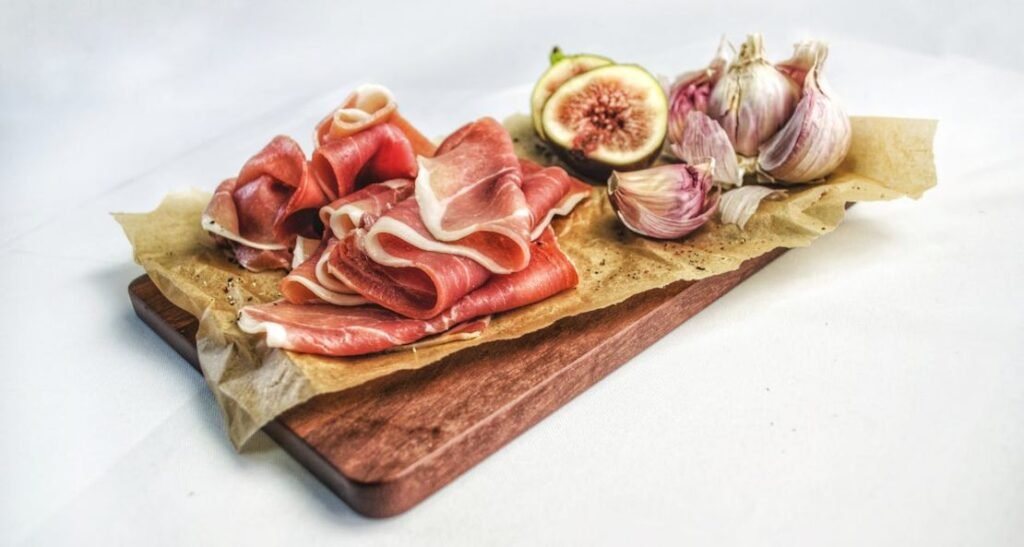Ever wondered why some Italian-Americans seem to have their own secret code for ordering deli meats?
Enter the world of “gabagool,” a word that’s more flavorful than the cured meat it refers to!
This quirky pronunciation of “capicola” isn’t just a mouthful; it’s become a pop culture darling and a linguistic puzzle that’s got everyone from TV writers to language nerds buzzing.
Born in the bustling Italian-American neighbourhoods of the northeastern United States, “gabagool” has worked its way from Nonna’s kitchen to prime-time TV.
But don’t worry if you can’t find “gabagool” in your Italian dictionary.
This little word is pure Italian-American magic, a perfect example of how immigrant cultures can spice up the English language in unexpected ways.
It’s not just about the meat; it’s a slice of history, a dash of cultural pride, and a whole lot of fun rolled into one delicious word.
So grab a sandwich and get comfortable as we dive into the story behind this culinary linguistic curiosity.
Whether you’re a word nerd, a food fan, or just someone who’s wondered why Tony Soprano doesn’t order his cold cuts like everyone else, you’re in for a treat.
Let’s unravel the mystery of “gabagool” and see how this tasty term became a true Italian-American superstar!
The Origins: From Capicola to Gabagool
In the late 1800s, and boatloads of Italians are arriving in America, their suitcases packed with dreams, traditions, and some seriously tasty cured meats.
Among these meaty treasures? Capicola is a delicious dry-cured pork that’s like prosciutto’s spicier cousin.
As these newcomers set up shop in places like New York, New Jersey, and Philadelphia, something magical started happening.
Their old-world dialects and new-world English started doing a funky linguistic tango.
The result? A spicy word stew that eventually cooked up our star ingredient: “gabagool”!
The Transformation: How Capicola Became Gabagool
So how did “capicola” turn into “gabagool”? It’s like the word went through a linguistic obstacle course!
Here’s the play-by-play:
1. The Vanishing Vowel Trick: Southern Italian dialects love to drop final vowels faster than a hot potato. “Capicola” became “capicol”. Ta-da!
2. The Vowel High Jump: The “o” in “capicol” decided to aim higher, becoming an “oo” sound. “Capicool” entered the chat.
3. The Consonant Swap: The “c” in “capicool” got tired of being quiet and became a loud “g.” And just like that, “gabagool” was born!
This word gymnastics routine became a hit in tight-knit Italian-American neighborhoods.
Before you knew it, “gabagool” was the coolest way to order your cold cuts!
Gabagool Goes Mainstream: Pop Culture Prominence
“Gabagool” might have started as an inside joke in Italian-American circles, but it wasn’t content to stay there.
Nope, this word had Hollywood dreams!
Enter “The Sopranos,” the TV show that made mobsters, therapy, and yes, deli meats, impossibly cool.
Tony Soprano’s love for gabagool put this quirky word on the map.
Suddenly, everyone from New Jersey to Nebraska was trying to order “gabagool” at their local deli.
Just like that, this little linguistic oddball became a full-blown cultural icon.
Even The Office invokes the term in its memorable mafia episode from 2009, which sees Michael Scott ordering “just the gabagool” to show off in front of his new Italian-American friends.
It wasn’t just a way to order food anymore; it was a slice of Italian-American identity served up on national television.
Who knew cured meat could cure America’s pronunciation blues?
The Culinary Delight: What is Gabagool (Capicola)?
Alright, food fans, let’s talk about the star of our linguistic show – capicola, aka the mighty gabagool!
This isn’t just any old deli meat; it’s a cured pork superstar that’s been making taste buds dance for generations.
Picture this: a chunk of pork shoulder or neck, lovingly seasoned with a secret blend of herbs and spices (maybe even a splash of wine for good measure), then stuffed into a casing and left to hang out for up to six months.
The result? A tender, fatty slice of heaven that’s like prosciutto’s cooler cousin.
In Italy, they take this stuff so seriously that some versions have their own protected status. It’s like the meat equivalent of a AAA-list celebrity!
Gabagool in the Kitchen: Culinary Versatility
Now, don’t go thinking gabagool is just a one-trick pony. Oh no, this versatile veggie-dodger is the life of the culinary party!
Slice it thin for an antipasti platter that’ll make your guests swoon. Stuff it in a sandwich (hello, muffuletta!) for a lunch that’ll make your coworkers jealous.
Feeling fancy? Toss it on a pizza and pretend you’re dining in Naples. The possibilities are endless!
The Enduring Legacy: Gabagool in Italian-American Culture
But gabagool isn’t just about filling bellies; it’s about filling hearts too.
For many Italian-Americans, this word is like a time machine, transporting them back to Nonna’s kitchen faster than you can say “mangia!”
It’s more than just a way to order at the deli; it’s a cultural badge of honour, a linguistic high-five to their heritage.
Every time someone says “gabagool,” an Italian grandmother somewhere smiles (and probably starts cooking).
So there you have it, folks, Gabagool in all its glory. It’s not just a food; it’s not just a word; it’s a slice of Italian-American history served up on a platter of linguistic fun. Now, who’s hungry?
You might also like:
- Understanding Mogging: An In-Depth Exploration of the Mogging Phenomenon
- The Resurgence of The Mob Wives Aesthetic: A Retro Trend Making Waves in 2024
- The Rise of Samsung’s Virtual Assistant: Unravelling the Viral Phenomenon of Samsung Girl
- British Chinese Food: A Transcontinental Culinary Adventure


